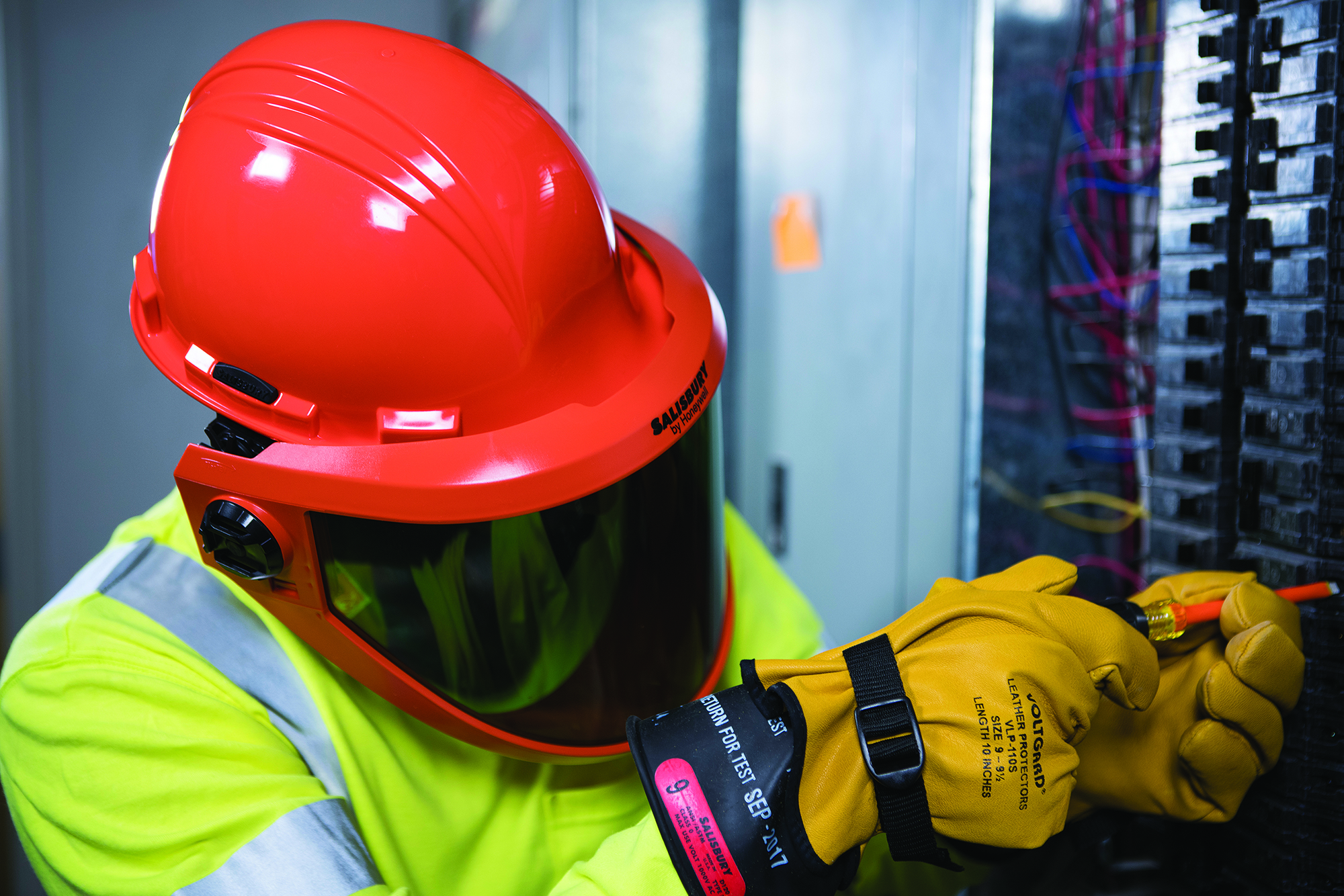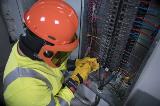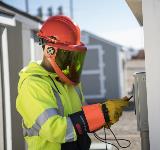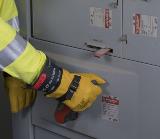Eliminating Confusion When It Comes to Working with Voltage-Rated Gloves & Leather Protectors to Protect Against Electric Shock

Electrical shock is the #1 hazard when it comes to servicing and performing maintenance on electrical systems in a commercial/industrial setting. It accounts for more than 90% of electrical-related fatalities among U.S. workers. Properly selected voltage-rated gloves and leather protectors are a worker’s first line of defense against electrical shock and are must-have PPE for electricians, electrical engineers or other qualified personnel who work on or around energized electrical systems. While voltage-rated rubber gloves and leather protectors have been around for years, there continues to be industry-wide confusion around the usage of these two products as a system for optimal protection against electrical shock. Do I have to wear leather protectors over my rubber gloves? Are there instances where it is OK to remove the leather protectors? What can be done for electrical applications requiring the utmost in dexterity? There are all kinds of theories and opinions around this matter. Given that the #1 cause of electrocution is inadequate or faulty safety gear, it is important for these answers to be readily understood. Having the right PPE and properly wearing/maintaining that PPE is paramount to decreasing the risk of electrocution when performing dangerous electrical work.
OSHA’s Position
 Protector gloves shall be worn over rubber insulating gloves per OSHA 1910.137 (c) (2) (vii) to provide the needed mechanical protection against abrasions, cuts, snags, punctures, etc. In certain high-dexterity applications however, OSHA’s 1910.137 (c) 2 (vii) (A) – (C) Electrical Protective Equipment standard does allow some exceptions. If the voltage is 250 volts AC (or 375 volts DC) or less, leather protector gloves do not need to be used with class 00 gloves under limited-use conditions when small equipment and parts manipulation necessitate the need for unusually-high finger dexterity. The standard also states that class 0 gloves (1000 volts AC max use voltage) can also be used without leather protector gloves under the same limited-use conditions where dexterity is critical. Any other class of gloves may be worn without leather protector gloves, under the same limited-use conditions, when small equipment and parts manipulation necessitate the need for unusually-high finger dexterity, but only if the employer can demonstrate that the possibility of physical damage to the glove is small and if the class of glove used is one class higher than required for the voltage involved. ANY rubber insulating gloves (class 00 through class 4) that have been used without leather protectors, per OSHA, may NOT be used again until they have been visually inspected and electrically re-tested by a certified testing facility. (And Saf-T-Gard can help with that as our NAIL-certified Voltgard® Test Lab can manage all your rubber glove testing needs!)
Protector gloves shall be worn over rubber insulating gloves per OSHA 1910.137 (c) (2) (vii) to provide the needed mechanical protection against abrasions, cuts, snags, punctures, etc. In certain high-dexterity applications however, OSHA’s 1910.137 (c) 2 (vii) (A) – (C) Electrical Protective Equipment standard does allow some exceptions. If the voltage is 250 volts AC (or 375 volts DC) or less, leather protector gloves do not need to be used with class 00 gloves under limited-use conditions when small equipment and parts manipulation necessitate the need for unusually-high finger dexterity. The standard also states that class 0 gloves (1000 volts AC max use voltage) can also be used without leather protector gloves under the same limited-use conditions where dexterity is critical. Any other class of gloves may be worn without leather protector gloves, under the same limited-use conditions, when small equipment and parts manipulation necessitate the need for unusually-high finger dexterity, but only if the employer can demonstrate that the possibility of physical damage to the glove is small and if the class of glove used is one class higher than required for the voltage involved. ANY rubber insulating gloves (class 00 through class 4) that have been used without leather protectors, per OSHA, may NOT be used again until they have been visually inspected and electrically re-tested by a certified testing facility. (And Saf-T-Gard can help with that as our NAIL-certified Voltgard® Test Lab can manage all your rubber glove testing needs!)
Safety is #1
 Leather protectors or protectors, as they are named, are designed to “protect” the voltage-rated glove underneath from damage. They are intended to be worn as a system to work as intended and to offer the maximum protection for the user. Keep in mind, the slightest cut, puncture, nick, or damage to the rubber glove can render it useless. So, keeping them protected and visually inspecting rubber gloves before every use is imperative. The Electrical Industry and associated Standards organizations do, however, recognize that dexterity can come into play in certain applications involving shock hazards and the use of voltage rated gloves and leather protectors. Afterall, it would not be safe if an electrical worker dropped a tool or made accidental contact with energized electrical parts due to dexterity issues with rubber gloves and protectors while performing work. In other words, if the use of leather protectors with the rubber glove creates some other unsafe condition that could lead to a hazard like an arc flash or arc blast, this is not good. For this reason, there are exception situations where voltage-rated gloves can be used without leather protectors for maximum dexterity and work with small parts. When these limited-use situations take place and rubber gloves are used without leather protectors, it is necessary (and required) that the rubber gloves be sent to a certified testing facility for proper visual inspection and an electrical re-test to confirm they are still fit for future use.
Leather protectors or protectors, as they are named, are designed to “protect” the voltage-rated glove underneath from damage. They are intended to be worn as a system to work as intended and to offer the maximum protection for the user. Keep in mind, the slightest cut, puncture, nick, or damage to the rubber glove can render it useless. So, keeping them protected and visually inspecting rubber gloves before every use is imperative. The Electrical Industry and associated Standards organizations do, however, recognize that dexterity can come into play in certain applications involving shock hazards and the use of voltage rated gloves and leather protectors. Afterall, it would not be safe if an electrical worker dropped a tool or made accidental contact with energized electrical parts due to dexterity issues with rubber gloves and protectors while performing work. In other words, if the use of leather protectors with the rubber glove creates some other unsafe condition that could lead to a hazard like an arc flash or arc blast, this is not good. For this reason, there are exception situations where voltage-rated gloves can be used without leather protectors for maximum dexterity and work with small parts. When these limited-use situations take place and rubber gloves are used without leather protectors, it is necessary (and required) that the rubber gloves be sent to a certified testing facility for proper visual inspection and an electrical re-test to confirm they are still fit for future use.
The Take-Away on Use of Rubber Gloves & Leather Protectors
- Severe injury or death can occur at voltages as low as fifty (50) volts and greater. No PPE is more important than your voltage-rated gloves and leather protectors to protect against electric shock (and arc flashes too).
- Leather protectors are designed to take the abuse and protect voltage-rated rubber gloves from dangerous cuts, snags, punctures, and other damage that would keep them from protecting you as intended. Rubber gloves alone can easily be damaged, so protectors play a key role.
- In certain situations, requiring the utmost dexterity to safely perform a task, it is OK to work without your leather protectors per OSHA. These limited-use situations should be the exception and not the rule!
- Always have your voltage-rated gloves visually inspected and electrically re-tested by a certified test lab after having been used without leather protectors.
Connect with Saf-T-Gard to Learn More
Industria l safety is our legacy going back 9 decades, and electrical safety is our specialty. For an overview of our electrical safety products and services, including proprietary our Voltgard® electrical safety products please visit Electrical Safety.
l safety is our legacy going back 9 decades, and electrical safety is our specialty. For an overview of our electrical safety products and services, including proprietary our Voltgard® electrical safety products please visit Electrical Safety.

